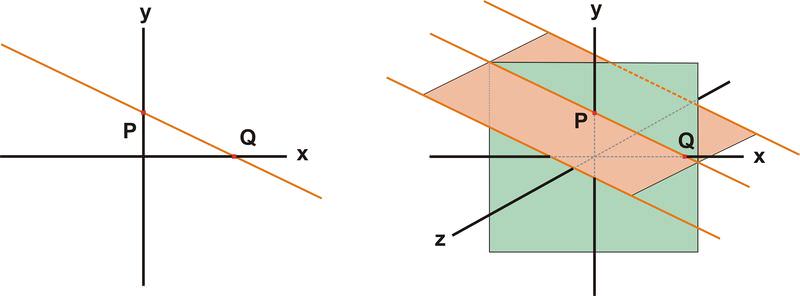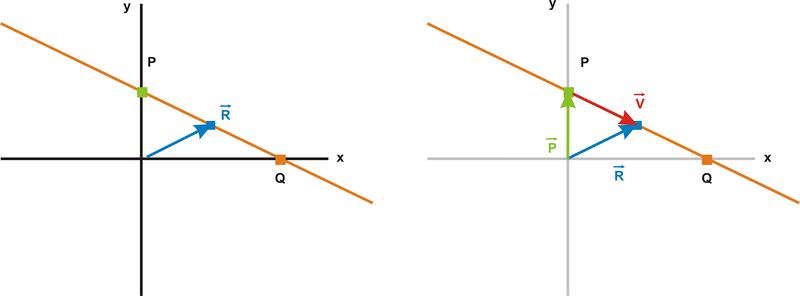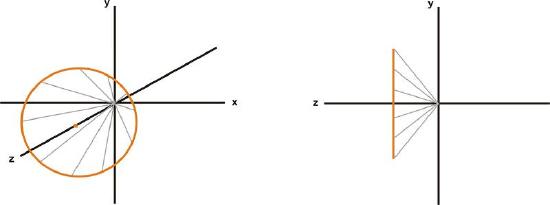5.4.1: Vector Equation of a Line
- Page ID
- 14670
Vector Equation of a Line
Air traffic control is tracking two planes in the vicinity of their airport. At a given moment, one plane is at a location 45 km east and 120 km north of the airport at an altitude of 7.5 km. The second plane is located 63 km east and 96 km south of the airport at an altitude of 6.0 km. The first plane is flying directly toward the airport while the second plane is continuing at a constant altitude with a heading defined by the vector \(\ \overrightarrow{h_{2}}=\langle 3,4,0\rangle\) to land eventually at another airport to the northwest of our air traffic controllers. Do the paths of these two aircraft cross?
Vector Equation of a Line
You are probably very familiar with using y = mx + b, the slope-intercept form, as the equation of a line. While this equation works well in two-dimensional space, it is insufficient to completely define the equation of a line in higher order spaces.
Lines in Space
In a two-dimensional plane, a line can be represented by the equation y = mx + b, where m is the slope of the line and b is the y-intercept. In three-dimensional space, this equation can represent a line or a plane or the projection of a 3D line onto the x-y plane. For example, in the diagram below, the line on the left passes through points P and Q. The equation in 2D space for this line is \(\ y=\frac{-P}{Q} x+P\)
The three orange lines in the diagram at right below can also be described by this equation. All three have slope \(\ M=\frac{-P}{Q}\) and y-intercept B = P. If we want to specify one of these lines in particular, we need to identify the line as the intersection of two planes. For example, the line where \(\ y=\frac{-P}{Q} x+P\) and \(\ z=0\) for all points is the intersection of the orange and green planes in the diagram below right. (Remember that the orange and green planes are drawn with edges for convenience, but that they represent planes that extend outward toward infinity.)

Therefore we can specify a particular line by requiring that the equations for both planes be simultaneously true. In a previous section we developed one equation for a plane given by d = -nx xo -ny yo -nz zo. In this case Qy + Px - QP = 0 and z = 0 must both be satisfied for all points on the line passing through points P and Q.
Finding the Vector Equation of a Line
Another way to identify points on a line can be found using the vector addition method we discussed earlier in this chapter. To find the position vector, \(\ \vec{r}\), for any point along a line, we can add the position vector of a point on the line which we already know and add to that a vector, \(\ \vec{v}\), that lies on the line as shown in the diagram below.

The position vector \(\ \vec{R}\) for a point between P and Q is given by \(\ \vec{R}=\vec{p}+\vec{v}\)
All other points on this line can be reached by traveling along the line from point P, therefore the position vector for any point on the line is given by \(\ \vec{r}=\vec{p}+k \vec{v}\).
If we know the locations of two points on a line, we can determine the equation of the line. All points on a line fulfill the equation \(\ \vec{r}=\vec{p}+k \vec{v}\), where k is a scalar that varies from -∞ to ∞. If we already know the position vectors for two points on the line, \(\ \vec{p}\) and \(\ \vec{q}\), we can use the method of vector subtraction to determine the equation of the vector, \(\ \vec{v}=\vec{p}-\vec{q}\). Therefore, \(\ \vec{r}=\vec{p}+k(\vec{p}-\vec{q})\), where k varies from -∞ to ∞.
General Vector Equations
In general, a vector equation is any function that takes any one or more variables and returns a vector. The vector equation of a line is an equation that identifies the position vector of every point along the line. This works for straight lines and for curves. For example, the vector equation \(\ \vec{p}=\langle 3 \cos \theta, 3 \sin \theta, 2\rangle\) defines a circle having a radius of 3 units which sits parallel to the x-y plane at a distance of 2 units along the z-axis as shown below. The orange line is the set of points that satisfy the vector equation \(\ \vec{p}=\langle 3 \cos \theta, 3 \sin \theta, 2\rangle\) while the grey lines are various individual position vectors which satisfy the vector equation.

Examples
Earlier, you were asked a question about two aircrafts.
Air traffic control is tracking two planes in the vicinity of their airport. At a given moment, one plane is at a location 45 km east and 120 km north of the airport at an altitude of 7.5 km. The second plane is located 63 km east and 96 km south of the airport at an altitude of 6.0 km. The first plane is flying directly toward the airport while the second plane is continuing at a constant altitude with a heading defined by the vector \(\ \overrightarrow{h_{2}}=\langle 3,4,0\rangle\) to land eventually at another airport to the northwest of our air traffic controllers. Do the paths of these two aircraft cross?
Solution
The first thing we need to do is to determine the position vectors of the two planes. Define our airport as the origin of coordinates and define \(\ \hat{x}=\text { east }\), \(\ \hat{y}=\text { north }\), and \(\ \hat{z}=\text { upward }\). Call the position of plane #1, P, and the position of plane #2, Q. This gives \(\ \vec{p}=\langle 45,120,7.5\rangle\) and \(\ \vec{q}=\langle 63,-96,6.0\rangle\).
Plane #1 is heading directly toward the airport. The vector from the position of plane #1 to the origin is given by
\(\ \begin{array}{l}
\vec{v}=\vec{o}-\vec{p}=\langle(0-45),(0-120),(0-7.5)\rangle \\
\vec{v}=\vec{p}-\vec{q}=\langle-45,-120,-7.5\rangle
\end{array}\)
The equation of the line representing plane #1’s motion then becomes
\(\ \overrightarrow{r_{1}}=\langle 45,120,7.5\rangle+k_{1}\langle-45,-120,-7.5\rangle \quad \overrightarrow{r_{1}}=\langle 45,120,7.5\rangle+k_{1}\langle-45,-120,-7.5\rangle\)
Plane #2 continues at a constant altitude with a heading \(\ \overrightarrow{h_{2}}=\langle 3,4,0\rangle\). The equation of the line representing plane #2’s motion then becomes
\(\ \begin{array}{l}
\vec{r}_{2}=\langle-63,96,6.0\rangle+k_{2}\langle 3,4,0\rangle \quad \overrightarrow{r_{2}}=\langle 63,-96,6.0\rangle+k_{2}\langle 3,4,0\rangle \\
\overrightarrow{r_{2}}=\langle-63,96,6.0\rangle+k_{2}\langle 3,4,0\rangle \\
\overrightarrow{r_{1}}=\langle 45,120,7.5\rangle+k_{1}\langle-45,-120,-7.5\rangle
\end{array}\)
If the paths of the two planes intersect, the position of that intersection must have coordinates which satisfy both equations.
To satisfy both equations, r1x must equal r2x, r1y must equal r2y, and r1z must equal r2z. This means that 45 - 45k1 = 63 + 3k2, 120 - 120k1 = -96 + 4k2, and 7.5 - 7.5k1 = 6.0 + 0k2 must all be simultaneously true.
The first equation simplifies to 15 - 15k1 = 21 + k2 or k2 = -6 - 15k1. The second simplifies to 30 - 30k1 = -24 + k2 or k2 = 54 - 30k1. The third equation simplifies to 7.5 - 7.5k1 = 6 or \(\ k_{1}=\frac{1}{5}\).
Inserting the value of k1 from the third equation into the first two equations, we find \(\ k_{2}=-6-15\left(\frac{1}{5}\right)=-6-3=-9 \text { and } k_{2}=54-30 k_{1}=54-30\left(\frac{1}{5}\right)=54-6=48\)
Since k2 = 33 and k2 = 0 cannot be simultaneously true, the two planes’ paths do not cross.
Note: There are other ways to reason through this problem. Can you find some? (Hint: Think of the geometry in 2-dimensions, or focus on the altitude as a way to simplify this problem).
Write the equation of \(\ y=-\frac{5}{3} x+5\) as a vector equation.
Solution
Start by choosing two points on the line, say \(\ (3,0)\) and \(\ (6,-5)\). Then \(\ \vec{p}=\langle 3,0\rangle\) and \(\ \vec{q}=\langle 6,-5\rangle\) So,
\(\ \vec{p}-\vec{q}=\langle 3,0\rangle-\langle 6,-5\rangle=\langle 3-6,0-(-5)\rangle=\langle-3,5\rangle\)
Finally, the vector equation of the line is
\(\ \vec{r}=\langle 3,0\rangle+k\langle-3,5\rangle=\langle 3-3 k, 5 k\rangle\)
Write the vector equation of the line defined by the points (2, 3, 4) and (-5, 2, -1).
Solution
These two points have position vectors ⟨2,3,4⟩ and ⟨−5,2,−1⟩. The vector of the line connecting the two points is given by
\(\ \begin{array}{l}
\vec{v}=\vec{p}-\vec{q}=\langle(2-(-5)),(3-2),(4-(-1))\rangle \\
\hat{v}=\vec{p}-\vec{q}=\langle 7,1,5\rangle
\end{array}\)
The equation of the line then becomes
\(\ \vec{r}=\langle 2,3,4\rangle+k\langle 7,1,5\rangle \quad \vec{r}=\langle 2,3,4\rangle+k\langle 7,1,5\rangle\)
Determine the equation for the line defined by the points P = (6, 7, 5) and Q = (3, 2, 11). Then find the position vector for a point, R, half-way between these two points.
Solution
\(\ \begin{array}{l}
\vec{v}=\vec{p}-\vec{q}=\langle(6-3),(7-2),(5-11)\rangle \\
\hat{v}=\vec{p}-\vec{q}=\langle 3,5,-6\rangle
\end{array}\)
The equation of the line then becomes
\(\ \vec{r}=\langle 6,7,5\rangle+k\langle 3,5,-6\rangle \quad \vec{r}=\langle 6,7,5\rangle+k\langle 3,5,-6\rangle\)
Since the vector \(\ \vec{v}\) points from P, the value of k for a particular point gives us some information about the location of that point. If 0 < k < 1, the point lies on the line between P and Q. If k< 0, the point is not between P and Q and is closer to P than Q. If k > 1, the point lies on the line between P and Q. If k < 0, the point is not between P and Q and is closer to P than Q. The point halfway between the two points has \(\ k=\frac{1}{2}\).
\(\ \begin{array}{l}
\vec{R}=\langle 6,7,5\rangle+\frac{1}{2}\langle 3,5,-6\rangle \\
\vec{R}=\langle(6+1.5),(7+2.5),(5+(-3)\rangle=\langle 7.5,9.5,2\rangle
\end{array}\)
Are the two vectors \(\ \vec{D}=\langle 1,-1,4\rangle+d\langle 1,-1,1\rangle\) and \(\ \vec{F}=\langle 2,4,7\rangle+f\langle 2,1,3\rangle\) skew lines or do they intersect one another?
Solution
If the two vectors intersect, there must be a point identified by position vector \(\ \vec{p}\) which satisfies the equations of both lines. In other words, we must be able to find values for d and f such that \(\ \vec{D}=\vec{F}\) or \(\ \langle 1,-1,4\rangle+d\langle 1,-1,1\rangle=\langle 2,4,7\rangle+f\langle 2,1,3\rangle\).
Each of the three components of vectors \(\ \vec{D}\) and \(\ \vec{F}\) must independently be equal if \(\ \vec{D}=\vec{F}\). This means that 1 + d = 2 + 2f, -1 - d = 4 + f, and 4 + d = 7 + 3f Combining the first two equations gives: 1 + d - 1 - d = 2 + 2f + 4 + f which when simplified becomes 0 = 6 + 3f or f = -2. If we substitute this back into the first equation we obtain, 1 + d = 2 + 2(-2) which when simplified becomes d = -3. If the two lines cross, f = -2 and d = -3 should satisfy each of the component equations.
1 + d = 2 + 2f becomes 1 + (-3) = 2 + 2(-2) or -2 = -2
-1 - d = 4 + f becomes -1 - (-3) = 4 + (-2) or +2 = +2
4 + d = 7 + 3f becomes 4 + (-3) = 7 + 3(-2) or +1 = +1
All three equations are equally satisfied, so the two lines do intersect and the point of intersection is (-2, 2, 1).
In physics, the motion of an object traveling at a constant speed is described by the equation \(\ \overrightarrow{s_{t}}=\overrightarrow{s_{i}}+\vec{v} t\) where si is the initial position, s is the position at some later time t, and v is the velocity of the object. Write the vector equation which returns the set of position vectors \(\ \vec{s}\) for an object having an initial position \(\ \overrightarrow{s_{i}}=\langle 2,3,4\rangle\) and a velocity of \(\ \vec{v}=\langle 1,1,-2\rangle\) and determine the object’s location at t = 10s.
Solution
\(\ \begin{array}{l}
\overrightarrow{s_{t}}=\overrightarrow{s_{i}}+\vec{v} t=\langle 2,3,4\rangle+t\langle 1,1,-2\rangle=\langle 2+t, 3+t, 4-2 t\rangle \\
\text { At } t=10 s, \overrightarrow{s_{10}}=\langle 2+10,3+10,4-2(10)\rangle=\langle 12,13,-16\rangle
\end{array}\)
An object has a position of \(\ \overrightarrow{s_{i}}=\langle 3,3,6\rangle\) at t = 0 and a velocity of \(\ \vec{v}=\langle 10,7,3\rangle\). Use the vector equation \(\ \vec{s}=\overrightarrow{s_{i}}+\vec{v} t\) to determine the distance traveled by the object between t = 3s and t = 5s. Distance measured in meters.
Solution
The vector equation describing the motion of the object is
\(\ \vec{s}=\vec{s}_{i}+\vec{v} t=\langle 3,3,6\rangle+t\langle 10,7,3\rangle=\langle 3+10 t, 3+7 t, 6+3 t\rangle\)
The object’s position at t = 3s is obtained from the vector equation:
\(\ \overrightarrow{s_{3}}=\overrightarrow{s_{i}}+\vec{v} t=\langle 3,3,6\rangle+(3)\langle 10,7,3\rangle=\langle 3+10(3), 3+7(3), 6+3(3)\rangle=\langle 33,24,15\rangle\)
The object’s position at t = 5s is obtained from the vector equation:
\(\ \overrightarrow{s_{5}}=\overrightarrow{s_{i}}+\vec{v} t=\langle 3,3,6\rangle+(5)\langle 10,7,3\rangle=\langle 3+10(5), 3+7(5), 6+3(5)\rangle=\langle 53,38,21\rangle\)
The distance traveled between these two points is the magnitude of the vector starting at (33, 24, 15) and ending at (53, 38, 21).
\(\ \overrightarrow{\triangle s}=\overrightarrow{s_{5}}-\overrightarrow{s_{3}}=\langle 53,38,21\rangle-\langle 33,24,15\rangle=\langle 20,14,6\rangle\)
Now we can use the Pythagorean theorem to determine the magnitude of the vector.
\(\ \overrightarrow{|\triangle s|}=\sqrt{a^{2}+b^{2}+c^{2}}=\sqrt{(20)^{2}+(14)^{2}+(6)^{2}}=25.1 \text { meters }\)
Determine the vector equation of the straight line defined by the points (2, 2, 2) and (1, 3, 5).
Solution
These two points have position vectors \(\ \vec{p}=\langle 2,2,2\rangle\) and \(\ \vec{q}=\langle 1,3,5\rangle\). The vector of the line connecting the two points is given by
\(\ \vec{v}=\vec{p}-\vec{q}=\langle(2-1),(2-3),(2-5)\rangle=\langle 1,-1,-3\rangle\)
The equation of the line, \(\ \vec{r}=\vec{p}+k \vec{v}\), then becomes
\(\ \vec{r}=\langle 2,2,2\rangle+k\langle 1,-1,-3\rangle \quad \vec{r}=\langle 2,2,2\rangle+k\langle 1,-1,-3\rangle\)
Do the two lines \(\ \vec{R}=\langle 4,4,-2\rangle+r\langle-3,7,2\rangle\) and \(\ \vec{K}=\langle 9,-8,7\rangle+k\langle-2,1,3\rangle\) intersect?
Solution
If the two vectors intersect, there must be a point identified by position vector \(\ \vec{p}\) which satisfies the equations of both lines. In other words, we must be able to find values for r and k such that
\(\ \vec{R}=\vec{K}\) or \(\ \langle 4,4,-2\rangle+r\langle-3,7,2\rangle=\langle 9,-8,7\rangle+k\langle-2,1,3\rangle\).
Each of the three components of vectors \(\ \vec{R}\) and \(\ \vec{K}\) must independently be equal if \(\ \vec{R}=\vec{K}\). This means that 4 - 3r = 9 - 2k, 4 + 7r = -8 + k, and -2 + 2r = 7 + 3k
Solving the second equation for k gives 12 + 7r = k. Now substitute this into one of the other two equations: 4 - 3r = 9 - 2(12 + 7r) or 4 - 3r = 9 - 24 - 14r which simplifies to 19 = -11r or \(\ r=\frac{-19}{11}=-1.727\). Substitute this value into one of the other equations: -2 + 2(-1.727) = 7 + 3k which becomes -2 - 3.454 = 7 + 3k. Solving for k gives k = -4.151. If the two lines cross, r = -1.727 and k = -4.151 should satisfy each of the component equations.
4 - 3r = 9 - 2k becomes 4 - 3 (-1.727) = 9 - 2(-4.151) or -1.181 = 17.302 Since even this first equation does not hold true, these two lines are skew and do not intersect.
Review
Write the vector equation of the line defined by the the following points:
- (2,−2,5) and (1,5,4)
- (2,−9,5) and (8,4,−6)
- (15,3,−3) and (4,−3,9)
- (−1,−1,7) and (3,11,8)
- (1,−3,2) and (−5,3,−1)
- (25,17,42) and (−16,12,23)
Determine if the two vectors are skew lines or if they intersect each other.
- \(\ \vec{D}=\langle 2,3,1\rangle+d\langle 5,3,6\rangle\) and \(\ \vec{F}=\langle-5,-3,-5\rangle+f\langle 15,3,-3\rangle\)
- \(\ \vec{D}=\langle 3,4,7\rangle+d\langle 3,3,2\rangle\) and \(\ \vec{F}=\langle-2,11,7\rangle+f\langle-2,11,7\rangle\)
- \(\ \vec{D}=\langle 15,3,-3\rangle+d\langle 3,11,8\rangle\) and \(\ \vec{F}=\langle 5,3,6\rangle+f\langle 1,-4,6\rangle\)
- \(\ \vec{D}=\langle 13,-1,6\rangle+d\langle-5,4,12\rangle\) and \(\ \vec{F}=\langle 6,9,0\rangle+f\langle 21,0,14\rangle\)
Identify the position vector for the midpoint of each line (you already found the vector equations in problems 1 through 4).
- (2,−2,5) and (1,5,4)
- (2,−9,5) and (8,4,−6)
- (15,3,−3) and (4,−3,9)
- (−1,−1,7) and (3,11,8)
Use the vector equation, and the following values for t: t = 3s and t = 5s. Distance measured in meters.
- An object has a position of \(\ \overrightarrow{s_{i}}=\langle 3,-5,1\rangle\) at t = 0 and a velocity of \(\ \vec{v}=\langle 2,7,-3\rangle\)
- An object has a position of \(\ \overrightarrow{s_{i}}=\langle 1,-4,-8\rangle\) at t = 0 and a velocity of \(\ \vec{v}=\langle 9,-7,3\rangle\)
- An object has a position of \(\ \overrightarrow{s_{i}}=\langle-1,2,-3\rangle\) at t = 0 and a velocity of \(\ \vec{v}=\langle 3,-1,-2\rangle\)
Vocabulary
| Term | Definition |
|---|---|
| position vector | A position vector describes the straight-line travel between a starting point (usually the origin) and the location of a second point on a coordinate plane. |
| Skew lines | Skew lines are lines that are in different planes and never intersect. |
| vector equation | A vector equation is any function that takes any one or more variables and returns a vector. |

